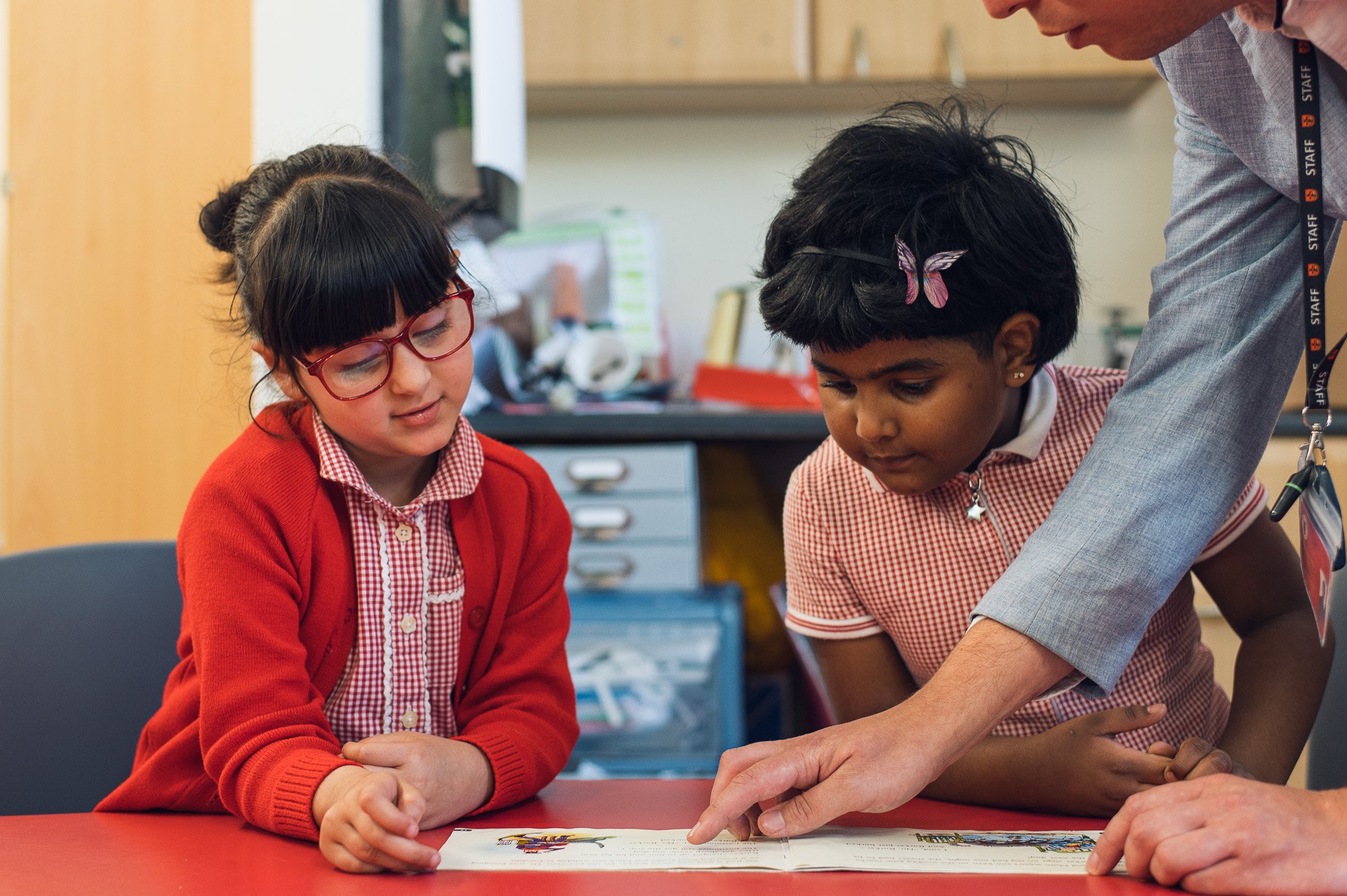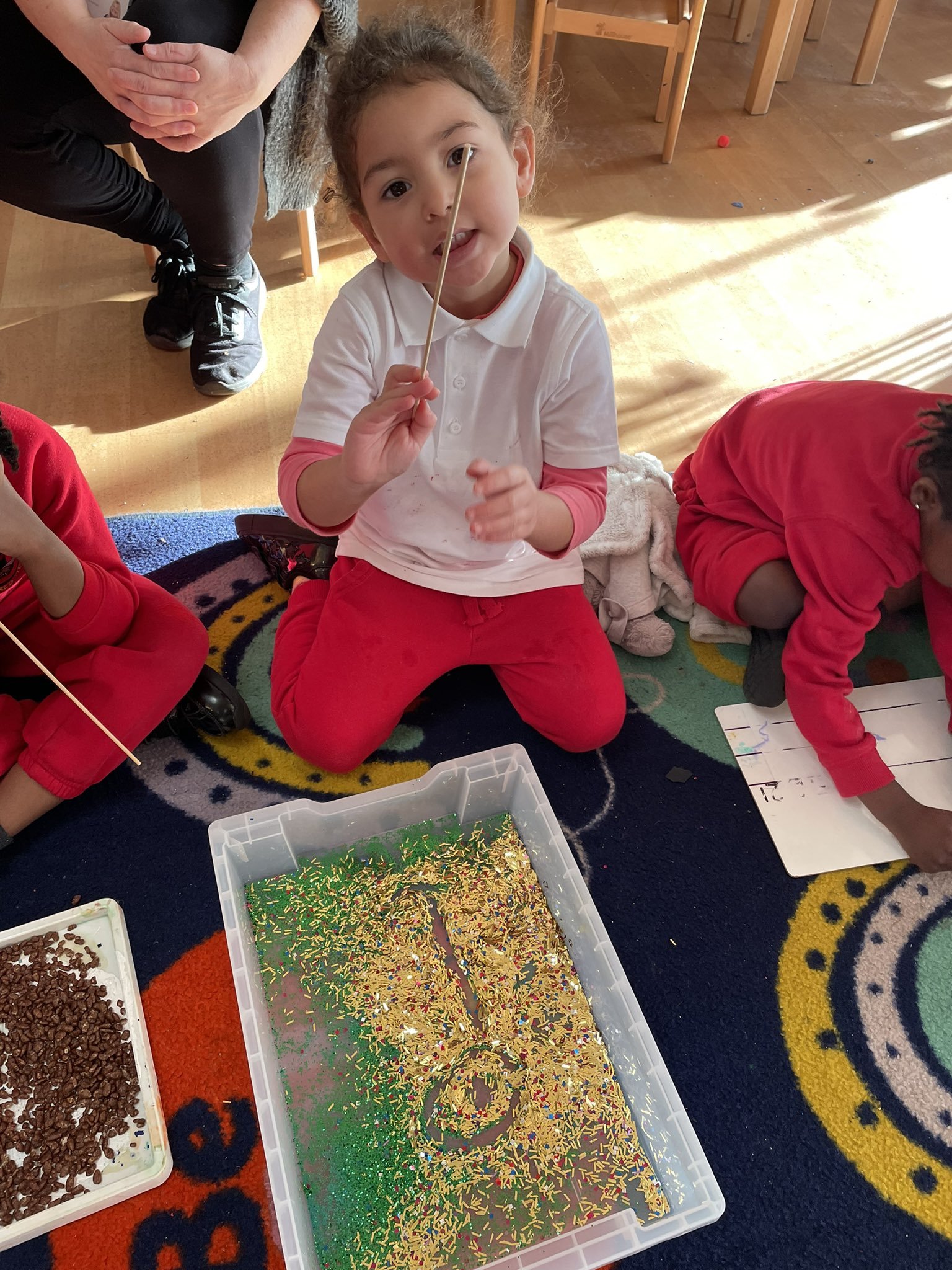
Phonics
Phonics
at Sacred Heart Primary School
At Sacred Heart Catholic Primary School and Nursery, our Intent is that through the teaching of phonics, we will equip children with the skills and knowledge to become independent and fluent readers. This in turn, will boost self-esteem and promote a love of learning, which will enable children to be proud of who they are and of what they can achieve.
Our families are from a varied and multi-cultural community, with children speaking many different languages, which makes our school rich in cultural diversity. Through the teaching of phonics, we want to promote a love of reading. We value reading as a key life skill, and are dedicated to enabling our children to become lifelong readers. Through daily phonics lessons, we set high expectations in speech, language and communication. We believe that being able to read fluently promotes a sense of self-worth, allows the children to learn at a deeper level, and gives them access to the wider curriculum.
At Sacred Heart Catholic Primary School and Nursery, we use the Read Write Inc. Phonics programme (RWI) which includes teaching synthetic phonics, sight vocabulary, decoding and encoding words as well as spelling and accurate letter formation. The Read Write Inc. (RWI) programme gets our children off to a flying start with their reading and writing. RWI is a rigorous and structured programme, which integrates phonics, comprehension, writing, grammar, punctuation, vocabulary and handwriting. We follow this programme with absolute fidelity to ensure that our children get out of the reading gateway as quickly as possible. The programme is now securely embedded at Sacred Heart, and it has helped us to create a consistent approach across our school as we all work together to ensure our children are confident readers and writers.
Our mission is to ensure that every child is as confident as soon as possible, as reading unlocks a child’s learning across our broad and ambitious curriculum.
Please visit Ruth Miskin’s website for parents to find out more about our wonderful programme…
https://www.ruthmiskin.com/parents/
RWI is a carefully structured systematic, synthetic, phonics programme designed for pupils in Reception, Year 1 and Year 2. The alphabetic code is taught in a certain order to ensure that children learn to read and write grapheme/phoneme correspondences accurately and fluently.
Once children become speedy at reading the first five sounds taught in Reception, they begin their journey to becoming independent blenders when reading words. We teach them how to use their reading routine (‘Special Friends, Fred Talk, Read the Word’) to read words accurately, build their fluency and become speedy word readers at each stage of the programme. Children then read matched texts, which only contain the sounds that they can read accurately. This means that your child will love bringing home their reading book and showing you, what they have been learning in school. We ask that you support them in building their fluency at home by re-reading texts each day to develop their fluency, expression and their understanding of what they are reading. The books are designed to be read a number of times to help confidence and fluency – your class teacher will explain this in detail at the Meet the teacher evenings and phonics workshops.
Implementation of Phonics
In order for children to read for meaning, phonic skills of decoding, segmenting and blending must be taught and built upon from the Early Years Foundation Stage, all the way through a child’s school journey to year 6.
We will support all children to learn to read through clear leadership; consistent teaching and learning approaches; regular monitoring and assessment along with a joint commitment between school and home. Phonics teachers, with support from the Phonics and English Lead, draw upon careful observations and continuous assessment to ensure children are challenged and to identify children who may need additional support. Phonics teaching takes place daily and pupils are taught in differentiated groups. The pupils rapidly learn phonemes and graphemes they need to represent them. Simple mnemonics help them to grasp this quickly. This is especially useful for pupils at risk of making slower progress.
Pupils have frequent practice in reading high frequency words with irregular spellings – common exception words. We make sure that pupils read books that are closely matched to their increasing knowledge of phonics and the common exception words. This is so that, early on, they experience success and gain confidence that they are readers.
All children read aloud during phonics or whole class reading. In addition, some pupils may read at least once more per week with a teacher, teaching assistant or reading volunteer; the focus being on the lowest 20%. At Sacred Heart, the systematic teaching of phonics has high priority in Foundation Stage and Key Stage 1. We use a synthetic phonics teaching programme produced by Ruth Miskin called Read Write Inc. (RWI) Phonics as a basis to teach our pupils to read and write. Pupils usually complete the programme by Year 2; some may even finish towards the end of Year 1. Pupils in Lower Key Stage 2 who need extra support with decoding may also follow the programme. For children in Upper Key Stage 2, who need extra practice to learn to read, we want to make sure they catch up quickly and leave our school a reader. Fresh Start is structured in the same way as the Phonics programme, but uses age-appropriate texts.
Pupils start Read Write Inc. phonics when they start EYFS, we group children by their reading progress during RWI sessions. The speed sound session lasts for minutes. We re-assess children every half term so we can place them in a group where they will make the most progress. Staff may also use ‘Pinny Time’ to revisit key sounds/words at incidental points throughout the day in. Through constant assessment, children are identified that need extra support to progress, therefore fast track one to one tutoring takes place for those pupils that are working below the expected levels. These interventions are designed to be short and intense.
RWI Phonics is presented in a simple but exciting format so that pupils can learn how to read and write sounds effortlessly. First we teach pupils the different pictures that relate to the sounds in the programme. This is introduced in Foundation 1 so that pupils are familiar with the images in preparation for further learning in F2. This is followed by learning one way to read and write the first 40+ sounds in English, using the pictures to help identify the different sounds. -We use a Frog called Fred to play ‘Fred Talk’ games to help with oral blending and to assist pupils when reading words by sound-blending. Fred says the sound and children help him blend the sounds to read each word. Then we teach the children different spellings of the same sounds and use phrases to help them remember each sound, for example, ‘may I play?’ accompanies the ay sound. We refer to speed sounds charts so that pupils can begin to make connections between the different graphemes they are learning to represent the sounds. -We want pupils to work together so teamwork is a key part of the RWI sessions.
Alongside this, the teachers read a wide range of stories, poetry and non-fiction to pupils; they are soon able to read these texts for themselves. Embedding the alphabetic code early on, means that pupils quickly learn to write simple words and sentences. We encourage them to compose each sentence aloud until they are confident to write independently. We make sure they write every day. Pupils write at the level of their spelling knowledge.
The quality of the vocabulary they use in their writing reflects the language they have heard in the books the teacher has read to them; they have also discussed what the words mean.
Our aim is for pupils to complete the phonics programme as quickly as possible. The sooner they complete it, the sooner they will be able to choose books to read at their own interest and comprehension level.
Impact of Phonics
Through the teaching of systematic phonics, our aim is for children to become fluent readers by the end of Key Stage 1.
With decoding taught as the prime approach to reading, pupils will become familiar with this strategy and have the confidence to work out unfamiliar words in any new texts they encounter even when they have come to the end of the RWI programme. Pupils will have the opportunity to develop their fluency and comprehension as they move through the school; accessing a range of texts independently.
Attainment in reading is measured using statutory assessments such as the end of EYFS, Key Stage 1 and 2 and following the outcomes in the Year 1 Phonics Screening check. Additionally, we track our own reading attainment through the use of RWI half termly and screening assessments, NFER reading papers, plus ongoing teacher assessment. More importantly, we believe that reading is the key to unlock all learning and so the impact of our reading goes beyond the statutory assessments. We give all the children the opportunity to enter the amazing new worlds that a book opens up to them and share texts from a range of cultures or genres to inspire them to question or seek out more for themselves. We want reading to be the golden thread running through a child’s journey at Sacred Heart. When they leave us, we want pupils to possess the reading skills and love of literature which will help them to enjoy and access any aspects of learning they encounter in the future.
In Nursery
Children have exposure to adults reading books and book language - fiction and non-fiction, songs, nursery rhymes daily.
There is a focus on traditional tales over the year and children should know six traditional tales inside out by the end of the year.
Children learn key book vocabulary: title, cover, illustration/illustrator, story, finding out, fact.
Children experience regular, planned opportunities to listen carefully and talk extensively about what they see, hear and do. Careful planning allows us to integrate the activities according to the developing abilities and interests of the children in the setting.
Children initially explore: and learn to discriminate: environmental sounds, instrumental sounds, body percussion, rhythm and rhyme, alliteration and voice sounds.
When they are ready, usually in the Summer Term, Set 1 letter sound correspondences are taught.
Reception and Beyond
Using RWI, we make learning to read easy for children because we start by teaching them just one way of reading and writing every sound. Here they are on the Simple Speed Sounds chart we use in class.
We teach Set 1 sounds first - (sounds as far as a e i o u).
We teach using pure sounds.
We pronounce the sounds clearly, using pure sounds (‘m’ not’ muh’, ’s’ not ‘suh’, etc.) so that your child will be able to blend the sounds together to make words more easily.
You can watch a video to hear how to pronounce the sounds here:
https://www.youtube.com/watch?v=TkXcabDUg7Q
Once children know one way of reading and writing every sound, they start to learn spellings for each sound they already know.
For example, they know ‘ay’ and now learn a-e and ai as other spellings for the same sound.
Alongside teaching children sounds, we teach them to blend sounds to read words e.g. s-a-t, sat.
We use Fred Talk to help children read.
This is Fred.
Fred can only speak in sounds.
He says d-o-g, h-a-t etc.
Speaking like Fred helps children to understand that words are made up of sounds.
Fred helps children practise blending sounds together because he needs the children to say the words for him. Fred says d-o-g, children tell him the word is dog.
You can use post it notes, magnetic letters or letter tiles to do this at home.
We use Fred Fingers to help children sound out words to spell easily.
It means they do not have to memorise lists of spelling words.
It is a tool so they will be able to spell any word.
We use green words in our lessons that are linked to the sounds being taught. These have the sound buttons and word on one side and the just the word on the other.
We have red words which used to be known as tricky words.
These have to be learned on sight.
We also read nonsense words to check our learning.
The phonics curriculum is designed to:
Develop reading skills.
Encourage fluency.
Give children a solid base upon which to build as children progress through school.
Phonics Screening Check
What is the Year 1 Phonics Screening Check?
The National phonics screening check was introduced in 2012 to all Year 1 pupils. It is a short, statutory assessment to ensure that children are making sufficient progress in the phonics skills to read words and are on track to become fluent readers who can enjoy reading for pleasure and for learning.
It is designed to give teachers and parents information on how your child is progressing in phonics. It will help to identify whether your child needs additional support at this stage so that they do not fall behind in this vital early reading skill.
What is in the Phonics Screening Check?
There are two sections in this 40-word check, half real words and half nonsense words, the nonsense words will be shown to your child with a picture of an alien. Your child will read up to four words per page for their teacher and they will probably do the check in one sitting of about 5-10 minutes.
What sort of check is it and is it compulsory?
It is a school-based check to make sure that your child receives any additional support promptly, should they need it. It is not a stressful situation as the teacher will be well-equipped to listen and understand your child’s level of skills. It should be an enjoyable activity for children which will take no more than 10 minutes.
What does it check?
It checks that your child can:
Sound out and blend graphemes in order to read simple words.
Read phonically decodable one-syllable and two-syllable words, e.g. cat, sand, windmill.
Read a selection of nonsense words which are referred to as pseudo words.
What are Nonsense Words or Alien Words and why are they included?
These are words that are phonically decodable but are not actual words with an associated meaning e.g. brip, snorb. Nonsense words are included in the check specifically to assess whether your child can decode a word using phonics skills and not their memory.
The nonsense words will be shown to your child with a picture of an alien and they will be asked to tell their teacher what sort of alien it is by reading the word.
This not only makes the check a bit more fun, but provides the children with a context for the nonsense word which is independent from any existing vocabulary they may have. Crucially, it does not provide any clues, so your child just has to be able to decode it.
Children generally find nonsense amusing so they will probably enjoy reading these words.
Is there a pass mark?
The check is not about passing or failing but checking appropriate progress is being made. If children do not reach the required standard, then the teacher will be in touch to discuss plans and offer additional, tailored support to ensure that your child can catch up. Children progress at different speeds so not reaching the threshold score does not necessarily mean there is a serious problem. Your child will re-sit the check the following summer term.
What happens to the results?
The school will report your child’s results to you by the end of the summer term as well as to the local authority, but the results won’t be published in a league table as with SATs. If you have any concerns, do talk to your teacher about this in a parents’ meeting or after school.
Do all schools have to participate?
All schools and academies in England must take part in the phonics screening check unless they are an independent school. There is a process in place for reviewing children with special educational needs, so if your child’s teacher thinks there are very special reasons related to your child and their needs that make them think the phonics screening check may not be appropriate, they will decide on appropriate action and discuss this with you.
What should I do if my child is struggling to decode a word?
Say each sound in the word from left to right following the sound guidance in the QR codes sent out to parents.
Work at your child’s pace.
Always be positive and give lots of praise and encouragement.
Progression Maps

Phonics in Action























